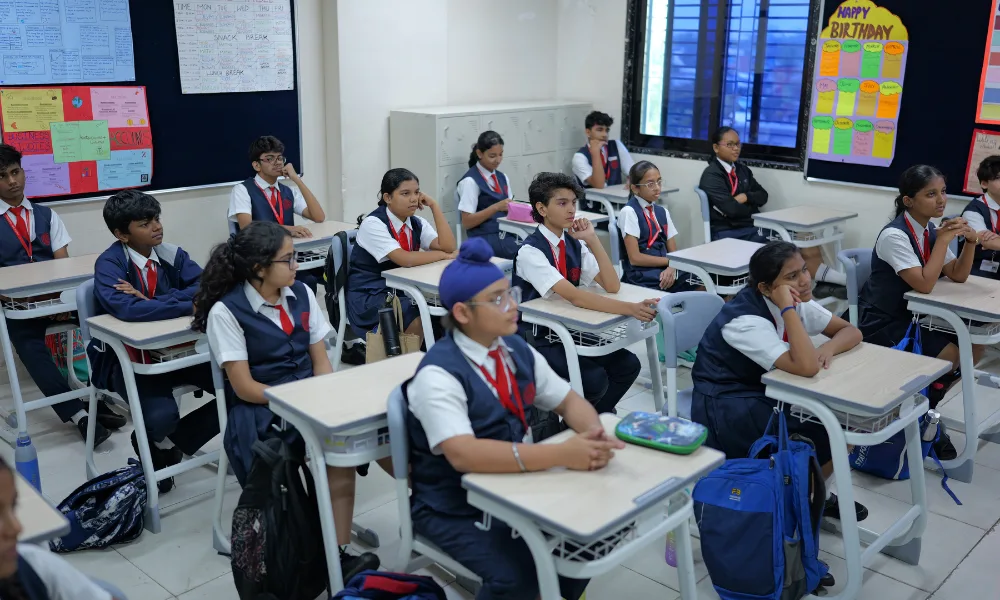Ways To Improve Student Behaviour In The Classroom
May 30, 2025 2025-05-30 16:13Ways To Improve Student Behaviour In The Classroom
Improving student behaviour in the classroom is one of the most crucial aspects of creating a productive and respectful learning environment.
Teachers, parents, and schools must work together to instill positive habits, build emotional intelligence, and encourage discipline in young learners. A well-behaved class allows teachers to teach more effectively and students to learn without disruptions.
In fact, many educators at the Best International Schools in Mumbai implement proactive behaviour strategies that go beyond discipline — they aim to shape character, responsibility, and leadership in students from the early years.
Let’s explore practical and research-backed methods that can help improve student behaviour in classrooms across all age groups.
Ways to improve student behaviour in the classroom:


1. Set Clear Expectations from Day One
Children respond well to structure. Teachers must establish clear rules, routines, and consequences from the very beginning of the school year.
- Explain classroom rules positively (e.g., “Speak respectfully” instead of “Don’t shout”).
- Reinforce these expectations regularly through visual cues and gentle reminders.
- Involve students in co-creating rules so they feel a sense of ownership.
2. Model Respectful Behaviour
One of the best ways to teach students how to behave is by showing them what respectful, responsible behaviour looks like.
- Always speak politely, even when correcting.
- Admit mistakes — this shows humility and honesty.
- Celebrate diversity and create an inclusive classroom where every student feels seen and heard.
When teachers model ideal student behaviour, it becomes easier for students to follow suit.
3. Build Strong Teacher-Student Relationships
Positive relationships form the foundation of good behaviour.
- Take time to learn students’ names, interests, and challenges.
- Use positive reinforcement over punishment.
- When students feel emotionally secure, they’re more likely to act respectfully.
Creating a bond helps teachers influence student behaviour with empathy rather than fear.
4. Use Positive Reinforcement and Incentives
Acknowledging good behaviour often works better than punishing bad behaviour.
- Praise specific actions, like “Thank you for helping your classmate.”
- Use rewards like extra playtime, leadership badges, or appreciation notes.
- Class-wide goals can encourage teamwork (e.g., filling a jar with tokens for good behaviour).
Positive reinforcement encourages repeat behaviour and builds motivation.
5. Engage Students in Active Learning
Boredom is one of the top reasons behind misbehaviour.
- Incorporate movement through activities like role-play, group discussions, and classroom games.
- Use multimedia tools and real-life examples to explain concepts.
- Offer choices in assignments to build autonomy.
An engaged classroom is a well-behaved classroom. Keeping lessons interactive directly impacts student behaviour.
6. Teach Emotional Regulation Skills
Sometimes misbehaviour stems from students not knowing how to manage emotions.
- Include short mindfulness or breathing exercises before starting a lesson.
- Teach terms like frustration, nervousness, or excitement so students can express themselves.
- Create a “calm corner” where students can cool down before rejoining class.
Helping students manage their emotions leads to fewer outbursts and better self-control.
7. Address Misbehaviour Calmly and Consistently
Every student makes mistakes. What matters is how teachers respond.
- Avoid raising your voice — stay calm and firm.
- Address the behaviour, not the child (e.g., “Throwing paper is not acceptable” instead of “You’re being bad”).
- Follow up with a one-on-one conversation to understand the reason behind the action.
Consistency in consequences helps students understand boundaries and builds trust.
8. Involve Parents and Caregivers
Parental involvement is a game-changer when it comes to shaping student behaviour.
- Share both achievements and concerns through regular communication.
- Ask about any emotional or social issues the student may be facing at home.
- Suggest simple routines or values that can be reinforced at home.
When school and home are on the same page, students get a consistent message.
9. Create Opportunities for Responsibility
Assigning tasks builds accountability.
- Rotate classroom jobs like line leader, board cleaner, or group captain.
- Encourage older students to mentor younger ones.
- Let students lead morning rituals or classroom discussions occasionally.
Taking responsibility gives students a sense of pride, which positively impacts their behaviour.
10. Reflect and Revise Behaviour Strategies Regularly
Every classroom and every child is unique. It’s essential for educators to reflect on what’s working and adjust accordingly.
- Use behaviour journals to track progress.
- Invite feedback from students: “What helps you stay focused?”
- Collaborate with fellow teachers to exchange tips and insights.
A flexible and open mindset ensures continuous improvement in managing student behaviour.
Final Thoughts
Improving student behaviour requires consistent efforts, empathy, and strategic classroom management. Whether it’s through building trust, promoting emotional intelligence, or using engaging teaching methods, the focus should always be on shaping long-term positive habits in children.
When schools prioritize these strategies — like those seen in the Best International Schools in Mumbai, they not only reduce disruptions but also cultivate confident, respectful, and responsible individuals.
Frequently Asked Questions (FAQs)
Ques 1. Why is student behaviour important in schools?
Ans. Good student behaviour creates a positive learning environment and reduces classroom disruptions.
Ques 2. How can teachers improve student behaviour?
Ans. By setting clear rules, building relationships, and using positive reinforcement.
Ques 3. What are common classroom behaviour problems?
Ans. Talking out of turn, not following instructions, and disruptive actions are common issues.
Ques 4. How do emotions affect student behaviour?
Ans. Unmanaged emotions like anger or anxiety can lead to disruptive actions.
Ques 5. How do inclusive classrooms manage behaviour better?
Ans. They create safe, respectful spaces that reduce behavioural issues.




